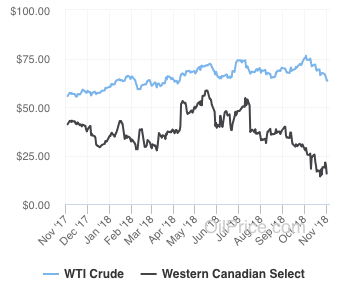A remarkable thing just happened in Canada’s oil patch. Tar sands producers have actually started to cut oil production in the face of growing pipeline constraints. It’s a small but concrete demonstration of the link between new transportation infrastructure like pipelines and climate pollution. It’s also a hint at how the wider oil and gas industry could act rationally to wind down production in the face of the urgent need to keep carbon in the ground.
In recent months, Alberta oil producers have faced an unprecedented drop in the price they are able to get for their oil. Tar sands oil has always been worth less than conventional crude as a result of its lower quality and the expense of shipping it to distant markets, but the discount is now also being driven by refinery outages and an increasingly full export pipeline system. The discount on Western Canada Select (WCS), a benchmark tar sands crude, has gone higher than $50/barrel compared with the North American benchmark, West Texas Intermediate (WTI), in recent months. That means that some tar sands producers are selling oil for less than $20 per barrel, losing large amounts of money at a time when global oil prices have been trending upwards. Tar sands producer Cenovus is moving to curtail its own production and is urging the rest of the sector to do the same.

Over the past decade, the oil industry has made numerous attempts to build massive tar sands export pipelines to get bitumen out of landlocked Alberta to market. The list of proposals is familiar – Keystone XL, Line 3, Trans Mountain Expansion, Northern Gateway, and Energy East. In each and every proposal, companies argued that oil would flow regardless of how many pipelines were built and, therefore, emissions from each project would be minimal. Thanks to fierce resistance from a connected movement standing up to uphold Indigenous rights and protect water, land, and the climate, none of these projects has moved forward.
And as reality now shows, without new pipelines, expanding production just isn’t financially viable. Suncor, one of the largest tar sands producers, has announced it won’t build another major expansion unless new pipelines are built. Some in the industry are now also proposing that the Alberta government, which collects its oil royalties in the form of actual barrels, could forgo them temporarily to allow for further production cuts across the sector. That would of course become a massive, unacceptable new public subsidy to private industry, but the discussion reveals both desperation and a recognition that production cuts are a viable solution to addressing low prices from the glut of oil. .
Clearly, public mobilization to stop pipelines is keeping huge amounts of carbon in the ground.
Alberta’s oil producers are now coming to grips with the fact that the only practical way to narrow the discount on their product is to negotiate amongst themselves to cut production.
This crisis came about because companies, particularly Suncor, CNRL and Cenovus, moved mega projects like Fort Hills, Foster Creek,and the Horizon expansion ahead presuming pipelines would be built in time and in the face of burgeoning domestic oil production in their key market, the United States. Competing with each other to produce as many barrels as possible has undermined the sector. In the face of this self-imposed crisis, collective action to negotiate and manage production declines could provide a viable path forward.
What’s happening in Alberta could be seen as a microcosm for the global oil and gas industry in the face of the climate crisis. It’s well understood that avoiding the worst impacts of climate change requires a rapid transition away from fossil fuels. If oil and gas companies continue to increase production in the face of growing market constraints and efforts to diminish global demand, they’ll drive down prices and hurt their bottom line. Lower prices also can induce more demand from consumers, undermining efforts to cut carbon. The best path forward for everyone involved is a negotiated, managed decline of production alongside efforts to cut demand for oil and gas. Cutting both supply and demand at the same time will ensure the best outcomes.
This model fits with growing calls for a sort of fossil fuel “non-proliferation” treaty, where governments and fossil fuel producers would negotiate collective reductions in the best interest of all. Perhaps we’ll get to see a version of what this could look like in miniature in Alberta in the coming weeks and months.

